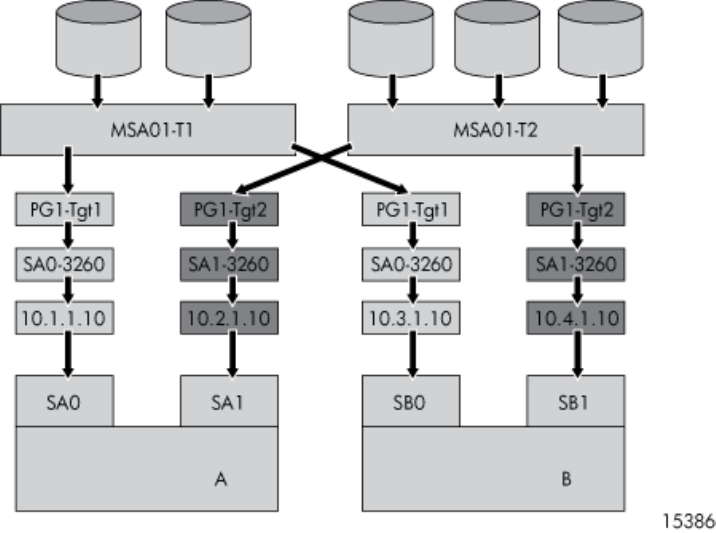HP StorageWorks 1510i Modular Smart Array iSCSI concepts and deployment guide (431338-002, July 2008)
Table Of Contents

Configuration v
ariables
The MSA1510i of
fers a great deal of configuration flexibility, with different configuration options providing
many possible
configurations. For example:
• Configure the MSA storage into ten LUNs, all mapped to one storage target, resulting in one target.
• Configure the MSA storage into ten LUNs, each mapped to a separate target, resulting in ten targets.
The following illustration demonstrates how iSCSI concepts pertain to their use on the MSA1510i.
As shown in the illustration, each layer is associated with layers adjacent to it and provides the
connectivity between the LUNs defined on the array and the IP address of the target. At each of the
layers, an opportunity exists to provide a logical abstraction.
Variables include:
• Number of targets — Storage targets provide a means of creating virtual MSAs on the network, by
associating multiple LUNs with a storage target, which is then visible on the network as a named
entity. For example, on a given MSA, a target can be created for each distinct business group, using
target alias names such as MSA011-T1 and MSA01-T2. Connecting to each target yields the LUNs
required to run each of these business groups. Different CHAP secrets can be placed on each of the
targets to restrict access to the initiators dedicated to the specific department. In addition, target
maintenance activities can be limited to that one group.
• Target-to-LUN mappings — When creating multiple targets on the MSA, an important consideration is
how many LUNs to map to a particular target. A balance must be determined between the desire to
organize the LUN use of a given MSA and the added complexity associated with each target. For
each target, a set of portals, portal groups, and LUN mappings must be managed. For example:
• Ten targets with one LUN per target — Ten login sessions and more management overhead, but
optimal I/O performance to the LUNs.
• One target with ten LUNs in that target — One login session and less management overhead, but
poorer I/O performance to the LUNs as all I/O requests pass through the one login session.
• Number of portals and portal groups — A target connects to the network through its assigned
portal groups. To obtain optimal performance, try to balance the traffic between the storage ports
when creating the portals, grouping them into portal groups, and then assigning them to a target.
For redundant configurations, the target must have at least two portal groups, with a storage portal
for each storage port associated with it, one for each controller.
1510i Modular Smart Array iSCSI concepts and deployment guide
31










